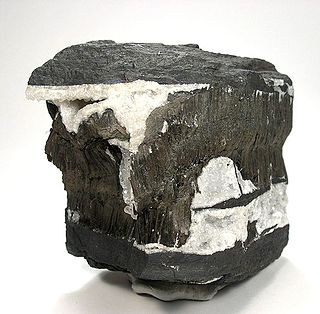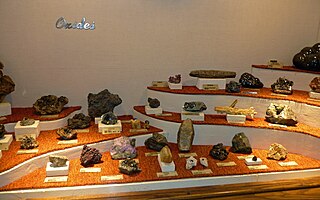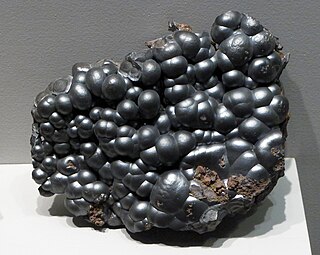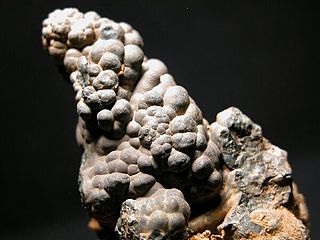Distribution
Ramsdellite is formed by oxidization of weathered manganese minerals such as manganite, and is often found in deposits containing various other manganese oxides. The mineral is relatively rare. The type locality, the place where Ramsdellite was first identified, is the Lake Valley district in Sierra County, New Mexico, US. Other locations in the USA where well-characterized samples of Ramsdellite have been found are Artillery Mountains, Arizona; Mistake mine, Yavapai County, Arizona; Idarado mine, near Telluride, Colorado; and Monroe-Tener mine, near Chisholm, Minnesota.
Good samples have been found in Canada along the East River in Pictou County, Nova Scotia; in Mexico in Los Gavilanes, Baja California; In India in Dongari Buzurg, Bhandara, Maharashtra; in Australia in the Iron Monarch quarry, Iron Knob, South Australia; in Japan in the Otoshibetsu and Tanno mines, Hokkaido; in the Czech Republic at Horní Blatná; in Germany at Bütten-Adenstadt, Lower Saxony and Clara Mine, near Oberwolfach, Black Forest; in Egypt at Gebel To Yu, Yoider, and Um Bogna; and in South Africa at Hotazel, near Kuruman, Northern Cape. Ramsdellite is found in the manganese deposits near Moanda, Haut-Ogooué Province, Gabon, mined by the Compagnie minière de l'Ogooué. These deposits were formed by supergene enrichment of Precambrian sediments.

Psilomelane is a group name for hard black manganese oxides including hollandite and romanechite. Psilomelane consists of hydrous manganese oxide with variable amounts of barium and potassium. Psilomelane is erroneously, and uncommonly, known as black hematite, despite not being related to true hematite, which is an iron oxide.

Pyrolusite is a mineral consisting essentially of manganese dioxide (MnO2) and is important as an ore of manganese. It is a black, amorphous appearing mineral, often with a granular, fibrous, or columnar structure, sometimes forming reniform crusts. It has a metallic luster, a black or bluish-black streak, and readily soils the fingers. The specific gravity is about 4.8. Its name is from the Greek for fire and to wash, in reference to its use as a way to remove tints from glass.

Manganite is a mineral composed of manganese oxide-hydroxide, MnO(OH), crystallizing in the monoclinic system (pseudo-orthorhombic). Crystals of manganite are prismatic and deeply striated parallel to their length; they are often grouped together in bundles. The color is dark steel-grey to iron-black, and the luster brilliant and submetallic. The streak is dark reddish brown. The hardness is 4, and the specific gravity is 4.3. There is a perfect cleavage parallel to the brachypinacoid, and less-perfect cleavage parallel to the prism faces. Twinned crystals are not infrequent.

The mineral group tantalite [(Fe, Mn)Ta2O6] is the primary source of the chemical element tantalum, a corrosion (heat and acid) resistant metal. It is chemically similar to columbite, and the two are often grouped together as a semi-singular mineral called coltan or "columbite-tantalite" in many mineral guides. However, tantalite has a much greater specific gravity than columbite (8.0+ compared to columbite's 5.2). Iron-rich tantalite is the mineral tantalite-(Fe) or ferrotantalite and manganese-rich is tantalite-(Mn) or manganotantalite.

Adamite is a zinc arsenate hydroxide mineral, Zn2AsO4OH. It is a mineral that typically occurs in the oxidized or weathered zone above zinc ore occurrences. Pure adamite is colorless, but usually it possess yellow color due to Fe compounds admixture. Tints of green also occur and are connected with copper substitutions in the mineral structure. Olivenite is a copper arsenate that is isostructural with adamite and there is considerable substitution between zinc and copper resulting in an intermediate called cuproadamite. Zincolivenite is a recently discovered mineral being an intermediate mineral with formula CuZn(AsO4)(OH). Manganese, cobalt, and nickel also substitute in the structure. An analogous zinc phosphate, tarbuttite, is known.

Hausmannite is a complex oxide, or a mixed oxide, of manganese containing both di- and tri-valent manganese. Its chemical formula can be represented as MnIIMnIII2O4, or more simply noted as MnO·Mn2O3, or Mn3O4, as commonly done for magnetite, the corresponding iron oxide. It belongs to the spinel group and forms tetragonal crystals. Hausmannite is a brown to black metallic mineral with Mohs hardness of 5.5 and a specific gravity of 4.8.

Todorokite is a complex hydrous manganese oxide mineral with generic chemical formula (Na,Ca,K,Ba,Sr)
1-x(Mn,Mg,Al)
6O
12·3-4H
2O. It was named in 1934 for the type locality, the Todoroki mine, Hokkaido, Japan. It belongs to the prismatic class 2/m of the monoclinic crystal system, but the angle β between the a and c axes is close to 90°, making it seem orthorhombic. It is a brown to black mineral which occurs in massive or tuberose forms. It is quite soft with a Mohs hardness of 1.5, and a specific gravity of 3.49 – 3.82. It is a component of deep ocean basin manganese nodules.

The oxide mineral class includes those minerals in which the oxide anion (O2−) is bonded to one or more metal alloys. The hydroxide-bearing minerals are typically included in the oxide class. Minerals with complex anion groups such as the silicates, sulfates, carbonates and phosphates are classed separately.

Nsutite is a manganese oxide mineral with formula: (Mn4+1−xMn2+xO2-2x(OH)2x where x = 0.06–0.07). It is found in most large manganese deposits and was first discovered in Nsuta, Ghana. Since then, it has been found worldwide. Nsutite is a dull mineral with a hardness of 6.5–8.5 and an average specific gravity of 4.45. Nustite is used as a cathode in zinc–carbon batteries, but synthetic manganese oxide is gradually replacing it.

Romanèchite ((Ba,H2O)2(Mn4+,Mn3+)5O10) is the primary constituent of psilomelane, which is a mixture of minerals. Most psilomelane is not pure romanechite, so it is incorrect to consider them synonyms. Romanèchite is a valuable ore of manganese, which is used in steelmaking and sodium battery production. It has a monoclinic crystal structure, a hardness of 6 and a specific gravity of 4.7–5. Romanèchite's structure consists of 2 × 3 tunnels formed by MnO6 octahedra.

Birnessite (nominally MnO2·nH2O), also known as δ-MnO2, is a hydrous manganese dioxide mineral with a chemical formula of Na0.7Ca0.3Mn7O14·2.8H2O. It is the main manganese mineral species at the Earth's surface, and commonly occurs as fine-grained, poorly crystallized aggregates in soils, sediments, grain and rock coatings (e.g., desert varnish), and marine ferromanganese nodules and crusts. It was discovered at Birness, Aberdeenshire, Scotland.

Jacobsite is a manganese iron oxide mineral. It is in the spinel group and forms a solid solution series with magnetite. The chemical formula is (Mn,Mg)Fe2O4 or with oxidation states and substitutions: (Mn2+,Fe2+,Mg)(Fe3+,Mn3+)2O4.

Seamanite, named for discoverer Arthur E. Seaman, is a rare manganese boron phosphate mineral with formula Mn3[B(OH)4](PO4)(OH)2. The yellow to pink mineral occurs as small, needle-shaped crystals. It was first discovered in 1917 from a mine in Iron County, Michigan, United States and identified in 1930. As of 2012, seamanite is known from four sites in Michigan and South Australia.

A native metal is any metal that is found pure in its metallic form in nature. Metals that can be found as native deposits singly or in alloys include aluminium, antimony, arsenic, bismuth, cadmium, chromium, cobalt, indium, iron, manganese, molybdenum, nickel, niobium, rhenium, selenium, tantalum, tellurium, tin, titanium, tungsten, vanadium, and zinc, as well as the gold group and the platinum group. Among the alloys found in native state have been brass, bronze, pewter, German silver, osmiridium, electrum, white gold, silver-mercury amalgam, and gold-mercury amalgam.
Akhtenskite is a manganese oxide mineral with the chemical formula of MnO2 (or: ε-Mn4+O2) that was named after the Akhtensk deposit in Russia, where it was first discovered and noted in 1979. It can be found in the Akhtensk brown ironstone deposit, in the southern Ural Mountains, on Mt. Zarod, on the Sikhote-Alin Mountains, and in the Primorskiy Krai, all in Russia.

Nickel–Strunz classification is a scheme for categorizing minerals based upon their chemical composition, introduced by German mineralogist Karl Hugo Strunz in his Mineralogische Tabellen (1941). The 4th and the 5th edition was also edited by Christel Tennyson (1966). It was followed by A.S. Povarennykh with a modified classification.

Cryptomelane (K(Mn4+,Mn2+)8O16) is the potassium endmember of the hollandite group, a family of tectomanganates with a 2 × 2 tunnel structure.

Picromerite is a mineral from the class of hydrous sulfates lacking additional anions, and containing medium to large cations according to the Nickel–Strunz classification.

Paramontroseite (V4+O2) is a relatively rare orthorhombic vanadium oxide mineral in the Ramsdellite group. Synthetic paramontroseite may have applications in medicine, batteries and electronics.


















